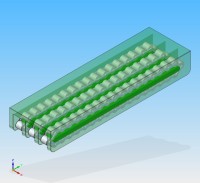 |
 |
|||||||||||||
|
|||||||||||||
|
|||||||||||||
|
Like the rest of society, the ILC community is split into two categories: the early risers and the night owls. Workshop organiser Andrei Seryi considers himself a night owl. Nevertheless he is up at 5 and in the lab at 6 am many days per week these weeks, holding phone meetings with the rest of the world. Some hundred specialists are already extremely busy preparing for the ILC interaction region engineering design workshop, or IRENG07, at SLAC in September. Their goal: to have all the facts together to take important decisions for the ILC’s interaction region. Getting everybody together at reasonable times means that the Americans have to rise early, the Asians have to stay up late, while the Europeans can sip a cup of afternoon coffee during the meeting. This timing has become standard procedure for ILC phone conferences and video meetings, though schedules rotate sometimes. Four different working groups for IRENG07 have formed and meet regularly. They discuss complicated issues with far-reaching consequences: the push-pull concept, adopted early this year as reference design, is a big challenge for detector and cavern design. “We have to study carefully all the integration aspects of the interaction region,” says Seryi. “How can we make the push-pull operation reliable and fast and not disturb the detector, especially its internal alignment? We are looking for answers to these questions.” The workgroups feature many members who already have a lot of experience in planning and realising other projects like LHC detectors and caverns, TESLA or XFEL. They know about pitfalls nobody would think of, have experience with cranes and moving and lowering huge slices of detectors far underground. Their expertise is spread over the different workgroups A (overall detector design, assembly, detector moving, shielding), B (IR magnets design and cryogenics system design), C (conventional construction of IR hall and external systems) and D (accelerator and particle physics requirements). The decision to have one interaction region for two detectors was taken because of considerable cost savings with this solution. Two detectors were always planned and remain the reference design, only not sitting in two individual caverns. They will share a cavern so that while one sits around the interaction point to take data, the other can be moved aside for maintenance. At the moment scientists think that the switch-over from one detector to the other could happen from once a year to once a month. The push-pull concept is not completely new, but it has never been tried at these scales. The cavern size, for example, has to be calculated very precisely. The cavern must be big enough to move the giant detectors around and provide space for additional shielding from the running beam according to health and safety regulations if the detectors are not self-shielding. The current planned size of the cavern is 120 by 25 by 35 metres, connected to the access shaft via a smaller service cavern. Interestingly, excavating the large hall is less expensive per cubic metre than excavating the service hall, which means that some services cold move to the detector hall to optimise costs. “A value engineering study that can serve as a leitmotif for the EDR process,” says Seryi. Moving the detectors is another challenge. At the workshop in September, the participants want to have a solution ready. Proposals include a platform under each detector to provide stability, to ensure that the detector does not move internally, destroying the intricate and micron-precise setup of detector components, and finally to make the detector easy to move - if easy is a word that can be used in a context where several thousand tons will be moved around! However, a platform alone would not solve all the problems. It doesn't move by itself, so to get it from parking position into the beam and vice versa, with the full load of the detector on top, you need stable, vibration-resistant transportation methods. One method are airpads, also used for the LHC's CMS detector. Another are so-called Hilman Rollers which look a bit like caterpillar 'wheels'. A third solution could be to move the detector without platform - some studies suggest that they are sturdy enough. More thorough studies will help the teams to come up with a recommendation. Or there's the assembly, which will be done aboveground like the CMS detector, though under different conditions. What kind of crane is best? What features do the surface buildings need? The workshop will address it all. Stay tuned for a report from the CMS experience and how CERN colleagues are helping in ILC IR design, and of course from the IRENG workshop itself! -- Barbara Warmbein |
|||||||||||||
| © International Linear Collider |

